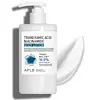What's inside
What's inside
 Key Ingredients
Key Ingredients

 Benefits
Benefits

 Concerns
Concerns

No concerns
 Ingredients Side-by-side
Ingredients Side-by-side

Water
Skin ConditioningCentella Asiatica Leaf Water
Skin ConditioningGlycerin
HumectantCetyl Ethylhexanoate
EmollientCetearyl Alcohol
EmollientGlyceryl Stearate
EmollientPEG-100 Stearate
Sorbitan Stearate
EmulsifyingCyclopentasiloxane
Emollient1,2-Hexanediol
Skin ConditioningSaccharide Hydrolysate
HumectantDimethicone
EmollientCyclohexasiloxane
EmollientStearic Acid
CleansingChlorphenesin
AntimicrobialCarbomer
Emulsion StabilisingGlyceryl Stearate Se
EmulsifyingCaprylyl Glycol
EmollientTranexamic Acid
AstringentNiacinamide
SmoothingXanthan Gum
EmulsifyingPotassium Hydroxide
BufferingDisodium EDTA
Butylene Glycol
HumectantDipropylene Glycol
HumectantSqualane
EmollientAsiaticoside
AntioxidantMadecassic Acid
Skin ConditioningAsiatic Acid
Skin ConditioningSodium Hyaluronate
HumectantMelaleuca Alternifolia Leaf Extract
PerfumingHippophae Rhamnoides Fruit Extract
Skin ConditioningHydrolyzed Collagen
EmollientBeta-Glucan
Skin ConditioningNelumbium Speciosum Flower Extract
Skin ConditioningArtemisia Annua Extract
MaskingOryza Sativa Extract
AbsorbentSaccharomyces Ferment
Skin ConditioningSolanum Melongena Fruit Extract
Skin ConditioningWater, Centella Asiatica Leaf Water, Glycerin, Cetyl Ethylhexanoate, Cetearyl Alcohol, Glyceryl Stearate, PEG-100 Stearate, Sorbitan Stearate, Cyclopentasiloxane, 1,2-Hexanediol, Saccharide Hydrolysate, Dimethicone, Cyclohexasiloxane, Stearic Acid, Chlorphenesin, Carbomer, Glyceryl Stearate Se, Caprylyl Glycol, Tranexamic Acid, Niacinamide, Xanthan Gum, Potassium Hydroxide, Disodium EDTA, Butylene Glycol, Dipropylene Glycol, Squalane, Asiaticoside, Madecassic Acid, Asiatic Acid, Sodium Hyaluronate, Melaleuca Alternifolia Leaf Extract, Hippophae Rhamnoides Fruit Extract, Hydrolyzed Collagen, Beta-Glucan, Nelumbium Speciosum Flower Extract, Artemisia Annua Extract, Oryza Sativa Extract, Saccharomyces Ferment, Solanum Melongena Fruit Extract
Sodium Hyaluronate
HumectantHydrolyzed Hyaluronic Acid
HumectantWater
Skin ConditioningGlycerin
HumectantDipropylene Glycol
HumectantTranexamic Acid
AstringentButylene Glycol
HumectantDiglycerin
HumectantPEG-8
HumectantPEG-6
HumectantPEG-32
HumectantStyrene/Vp Copolymer
Polysorbate 20
EmulsifyingHydroxylated Lecithin
EmulsifyingCitric Acid
BufferingTocopherol
AntioxidantMagnesium Ascorbyl Phosphate
AntioxidantPentylene Glycol
Skin ConditioningPhenoxyethanol
PreservativeDipotassium Glycyrrhizate
HumectantDisodium EDTA
Sodium Hyaluronate, Hydrolyzed Hyaluronic Acid, Water, Glycerin, Dipropylene Glycol, Tranexamic Acid, Butylene Glycol, Diglycerin, PEG-8, PEG-6, PEG-32, Styrene/Vp Copolymer, Polysorbate 20, Hydroxylated Lecithin, Citric Acid, Tocopherol, Magnesium Ascorbyl Phosphate, Pentylene Glycol, Phenoxyethanol, Dipotassium Glycyrrhizate, Disodium EDTA
 Reviews
Reviews

Ingredients Explained
These ingredients are found in both products.
Ingredients higher up in an ingredient list are typically present in a larger amount.
Butylene Glycol (or BG) is used within cosmetic products for a few different reasons:
Overall, Butylene Glycol is a safe and well-rounded ingredient that works well with other ingredients.
Though this ingredient works well with most skin types, some people with sensitive skin may experience a reaction such as allergic rashes, closed comedones, or itchiness.
Learn more about Butylene GlycolDipropylene Glycol is a synthetically created humectant, stabilizer, and solvent.
This ingredient helps:
Dipropylene glycol is technically an alcohol, but it belongs to the glycol family (often considered part of the ‘good’ alcohols). This means it is hydrating and gentle on skin unlike drying solvent alcohols like denatured alcohol.
As a masking agent, Dipropylene Glycol can be used to cover the smell of other ingredients. However, it does not have a scent.
Studies show Dipropylene Glycol is considered safe to use in skincare.
Learn more about Dipropylene GlycolDisodium EDTA plays a role in making products more stable by aiding other preservatives.
It is a chelating agent, meaning it neutralizes metal ions that may be found in a product.
Disodium EDTA is a salt of edetic acid and is found to be safe in cosmetic ingredients.
Learn more about Disodium EDTAGlycerin is already naturally found in your skin. It helps moisturize and protect your skin.
A study from 2016 found glycerin to be more effective as a humectant than AHAs and hyaluronic acid.
As a humectant, it helps the skin stay hydrated by pulling moisture to your skin. The low molecular weight of glycerin allows it to pull moisture into the deeper layers of your skin.
Hydrated skin improves your skin barrier; Your skin barrier helps protect against irritants and bacteria.
Glycerin has also been found to have antimicrobial and antiviral properties. Due to these properties, glycerin is often used in wound and burn treatments.
In cosmetics, glycerin is usually derived from plants such as soybean or palm. However, it can also be sourced from animals, such as tallow or animal fat.
This ingredient is organic, colorless, odorless, and non-toxic.
Glycerin is the name for this ingredient in American English. British English uses Glycerol/Glycerine.
Learn more about GlycerinSodium Hyaluronate is hyaluronic acid's salt form. It is commonly derived from the sodium salt of hyaluronic acid.
Like hyaluronic acid, it is great at holding water and acts as a humectant. This makes it a great skin hydrating ingredient.
Sodium Hyaluronate is naturally occurring in our bodies and is mostly found in eye fluid and joints.
These are some other common types of Hyaluronic Acid:
Learn more about Sodium HyaluronateTranexamic Acid is best used for treating hyperpigmentation, discoloration, and melasma. It can also help build a stronger skin barrier.
Once applied, Tranexamic Acid starts decreasing inflammation from UV exposure. Tranexamic Acid also prevents our skin cells from meeting the pigment production cells.
Its brightening property makes it great at reducing the appearance of acne scars and marks.
Fun fact: Tranexamic Acid is also a medication used to reduce heavy bleeding.
This acid is derived from lysine, an amino acid.
Learn more about Tranexamic AcidWater. It's the most common cosmetic ingredient of all. You'll usually see it at the top of ingredient lists, meaning that it makes up the largest part of the product.
So why is it so popular? Water most often acts as a solvent - this means that it helps dissolve other ingredients into the formulation.
You'll also recognize water as that liquid we all need to stay alive. If you see this, drink a glass of water. Stay hydrated!
Learn more about Water